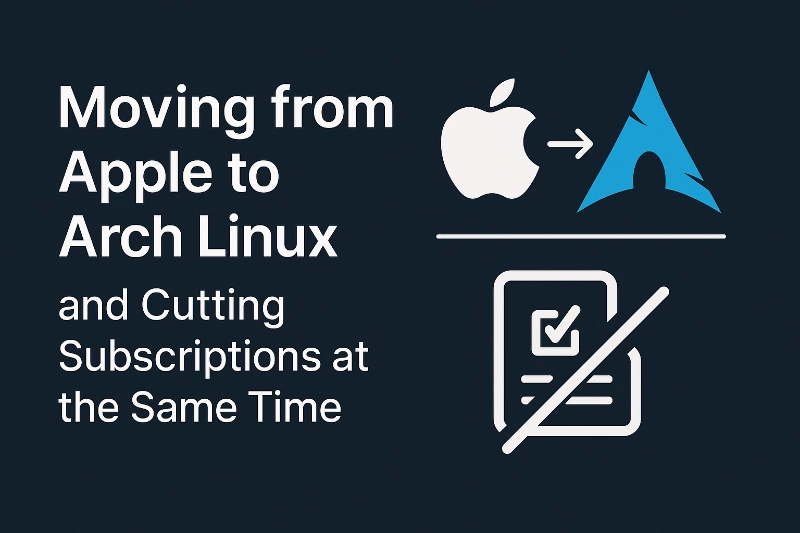This post might come across as a bit of a rant about the current state of tech, but it’s really about how I’m trying to simplify my setup — moving to Arch Linux and reducing my reliance on subscription-based tools.
The Apple Problem
I’ve been a bit of an Apple fanboy for years — especially when it comes to MacBooks. They just worked out of the box, and I rarely had to think about what was going on behind the scenes. But over the past year, I’ve noticed that managing development environments on macOS has become increasingly painful.
Recently, my MacBook ran a system update that, for reasons I still don’t understand, deleted my SQL Server management app — along with all the associated data. It was a disaster. This was the tool I used to manage both my SQL and Postgres databases, and since it ran quietly in the background, I couldn’t even remember what it was called at first.
After hours of searching through backups (with no luck), I realised how fragile my workflow had become. Setting up a simple development environment on macOS now feels harder than it should — and on top of that, everything seems to be moving to a subscription model. It’s getting annoying, and expensive.
Development Frustrations
When starting a new project recently, I tried setting up Ruby on Rails 8 on my M1 Mac. What should’ve been a quick setup turned into a series of errors and compatibility issues. I had to hack my way through Ruby, Python, and PHP installs — and every time I updated something, something else broke.
Some weeks, I’d lose entire days just fixing environments instead of actually coding.
The obvious solution was Docker, but I never found the time to learn it properly. I understood the basics, but not enough to make it part of my daily workflow. That’s something I’m finally changing now.
The Hardware Factor
My current MacBook Pro is a few years old. Its battery life has dropped from lasting about a day and a half to barely a third of that. Replacing it would cost around £3,500, which just doesn’t feel worth it anymore.
Instead, I bought a Lenovo ThinkPad T480 — an Intel i7 with 16GB of RAM and a 512GB SSD. Sure, that’s modest by today’s standards, but the real beauty of the T480 is that everything is upgradeable: SSD, RAM, battery, screen, even the keyboard.
It’s the perfect machine to experiment with Linux — and if I get stuck, I can always fall back to the Mac for specific tasks.
Subscription Fatigue
Most of the tools I use these days come with a subscription. Take Laravel Herd, for example — a fantastic tool that lets you manage multiple PHP environments seamlessly. But if you want to do something as simple as testing emails, you need a paid plan.
I’m not picking on Herd; it’s great software. But it’s symbolic of a bigger issue — everything is becoming a subscription.
I used to write bash scripts to automate my setups, but as dependencies update and tools change, things break. It’s a never-ending cycle.
So, I’ve decided to start moving away from closed or paid ecosystems where possible, and toward open-source, self-hosted, or DIY solutions. That includes rethinking my hosting and domain setups, which have become costly and time-consuming to maintain.
Enter Omarchy and Arch Linux
After some research, I discovered Omarchy, a developer-focused Linux setup built on Arch Linux and the Hyprland tiling window manager. It was configured by DHH (David Heinemeier Hansson) — the creator of Ruby on Rails — to make development as simple and fast as possible.
Installing it on my ThinkPad was straightforward: I flashed the ISO to a USB stick, booted it up, and it just worked.
I already use Linux daily for server work, and most of my workflow revolves around the terminal and Vim, so the switch felt natural. The only adjustment was the slightly different keyboard layout.
Omarchy relies heavily on tiling windows and keyboard shortcuts, which I already used on macOS through tools like Rectangle and Alfred, so it feels familiar.
The developer experience has been fantastic so far. With just a few commands, I’ve set up:
- a Ruby on Rails environment,
- a Docker-based MySQL and Laravel/PHP stack, and
- a Python environment.
The only thing missing is a Herd-like project manager for Laravel. But honestly, that’s a good thing — it’s forcing me to learn Docker properly, and now each of my projects has its own Dockerfile.
Downsides (So Far)
Not everything is perfect. The AUR package manager is slow. Installing Brave, for example, took nearly five hours before I gave up. From what I understand, AUR builds everything from source, which explains the slowness — especially on my T480’s current hardware (upgrades coming soon).
But even with that, I feel more in control of my setup than I have in years.
Final Thoughts
Moving from macOS to Arch Linux isn’t just about changing operating systems. It’s about taking back control — from the constant subscription creep, from locked-down systems, and from the feeling that my tools are deciding how I should work.
Arch (and Omarchy in particular) gives me freedom. It’s a bit rough around the edges, but it’s mine — and that’s worth more than convenience.
